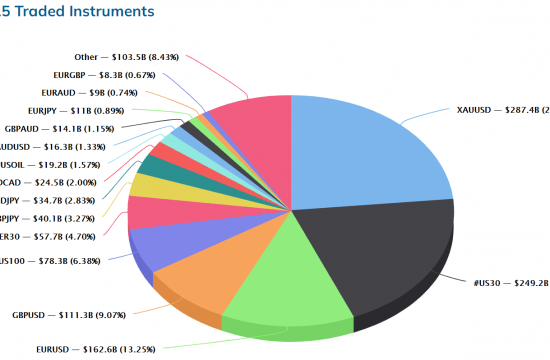 Bradley Jones[*]
Bradley Jones[*]
Head of International Department
Conference on ‘Asset Owners and Investment for the Long-term’ Judge Business School, Cambridge University
Cambridge –
Introduction
Thank you for the invitation to offer some reflections on reserve management and financial stability. For much of the period following the introduction of the classical gold standard in the mid-late nineteenth century, the portfolio behaviour of central bank reserve managers was a prosaic affair. Reserve assets were of modest size and passively managed in a small set of conservative investments. A high degree of risk aversion reflected the purely liability-driven nature of reserve management. In the years bookended by the two World Wars, large losses experienced by the few central banks willing to search for yield underscored the perils of investment adventurism. The principal occupation of most reserve managers was therefore in managing operational costs and discharging administrative duties–not generating active investment returns in the riskier corners of security markets. Prior to the breakdown of the Bretton Woods system in the 1970s, many central banks did not even bother to report their investment returns. All of this is to say that the portfolio actions of reserve managers rarely featured in discussions in policy circles or a wider public setting.
However the early-mid 2000s marked a fundamental shift in the operating environment for reserve managers. This reflected unprecedented growth in the size of reserve assets, and the more expansive risk tolerance occasioned by it. It was against this background that events during the global financial crisis first revealed an unintended tension between procyclical reserve management and international financial stability. I will posit today that one key lesson to have emerged from this experience is that what might appear rational behaviour for an individual reserve manager in a financial panic–cutting losses in risky securities, pulling bank funding, shutting down securities lending programs, and demanding liquidity–can inadvertently amplify negative externalities for the wider international financial system. In other words, procyclical portfolio adjustments by reserve managers could potentially work against the market stabilization efforts of other central banks during periods of turmoil. I should be clear that this might not ordinarily be a concern, except, as I will revisit later, under a particular set of circumstances. For instance: where international reserve assets are sufficiently large to impact asset prices (at least at the margin) and are concentrated in a small number of institutions (increasing the likelihood of correlated portfolio shifts); where reserve manager portfolio changes are, in aggregate, synchronized with those of private investors; and where reserve managers overestimate their own institution’s tolerance for risk.
It is worth highlighting at the outset that this possible tension between domestic and international financial stability emanating from procyclical reserve management practices has only recently started to attract attention from the policy community–in contrast to the well-trodden literature on reserve adequacy focused on what constitutes an appropriate level of reserves (rather than how they are invested). This connects back to the point that for many decades, changes to the portfolios of reserve managers were considered to have few, if any, implications for wider financial system functioning. To cite one example of this sharpened focus, the IMF’s recently revised Guidelines for Foreign Exchange Reserve Management (2013) now call for reserve managers to recognize the risk that their actions, whether directly (through firesales) or indirectly (through signalling effects), could result in “disruptive impacts on credit and financial markets” that “may fuel market trends”.
More broadly, while dampening procyclicality in the banking sector has attracted the attention of policy makers for the better part of a few centuries, the issue remains a greenfield area as it relates to large institutional asset owners. But with central banks, sovereign wealth funds (SWFs), pension funds, insurers and endowments now collectively administering a larger pool of capital than banks (a gap that is widening), policy attention is beginning to shift.[1] This reflects growing recognition that if the willingness of large asset owners to bear risk diminishes in stress periods and increases in upturns, capital can be misallocated and movements in risk premiums can be magnified to an extent that sets off economically harmful feedback loops.
Against this backdrop, my remarks today seek to address the following questions. First, how are official reserve management practices evolving to mirror important aspects of private institutional investor behaviour over time, and what are the policy implications of this convergence? Second, how did the procyclical portfolio behaviour of at least some reserve managers manifest during the crisis? Third, have developments over the decade since dampened the prospects for a repeat cycle? Finally, what can reserve managers practically do to better insulate themselves from the need to engage in procyclical portfolio adjustments when market conditions become disorderly?
The Evolution in Reserve Management–Beyond the ‘Safety and Liquidity’ Mantra
One of the questions underpinning this conference asks what is special about large, long-term asset owners? As a conceptual starting point, one might consider them endowed with some competitive advantages, and that availing of these could also serve a dual purpose in supporting financial stability and economic growth. For instance, their relatively stable risk preferences might empower asset owners to lean against excessive swings in risk premia, thus conferring a stabilizing influence on market cycles. More tolerance for short-term volatility could translate into bearing the types of risks that other investors pay a premium to avoid. And asset owners with long-dated liabilities should also be natural suppliers rather than demanders of liquidity, an approach that can be both individually profitable and helpful in stabilizing markets during disorderly conditions.
In practice, however, matters are rarely this straightforward. As the “limits to arbitrage” literature makes clear, a host of frictions and competing objectives can impede the ability of asset owners to lean against the wind. Moreover, while all asset owners face constraints of one sort or another, these have tended to be most pronounced for reserve managers (Table 1). In a historical sense at least, most notable has been the subordination of return generation to a broader set of policy objectives, a reflection that the narrow activity of reserve management is nested in the wider, non-profit maximizing objectives of the central bank as a whole. Understanding the types of investment and liquidity risks reserve managers will be willing and able to bear therefore requires understanding the policy context for holding reserves, and the circumstances in which they might be called on.
| Asset Owner Type | Financial Stability Objectives | Nature of Liabilities | Short-term Liquidity Needs | Reputational Concerns | Regulatory Constraints | Peer Benchmark Pressure |
|---|---|---|---|---|---|---|
| Central Bank Reserve Managers | High Importance | Explicit/Contingent | High | High | n.a. | Low |
| Stabilization- based SWFs | Med/High Importance | Explicit/Contingent | High | High | n.a. | Low |
| Savings-based SWFs | Med/Low Importance | Implicit | Low | High | n.a. | Med/High |
| DB Pension Funds | n.a. | Explicit | Medium/Low | Medium | High | Medium |
| DC Pension Funds | n.a. | Implicit | Low | Med/Low | Medium | Med/High |
| Insurance Companies | n.a. | Explicit/Contingent | Med/Low | Med/Low | High | Medium |
| Endowments & Foundations | n.a. | Implicit | Low | Med/High | Low | High |
| Source: Jones (2018) | ||||||
This is an appropriate point to briefly review the rationale for holding reserves, which can be broadly categorized along precautionary insurance and operational (non-emergency) lines. Precautionary reserves are held to defend the exchange rate against destabilizing capital outflows; to grant emergency foreign currency liquidity assistance to banks; and to lean against disorderly market conditions and/or valuation overshooting. Standard operational functions served by reserves include facilitating regular international debt and import-related payments on behalf of the government; serving as collateral to relax external borrowing constraints; and assisting with liquidity operations related to monetary policy implementation. The exchange rate regime, policy credibility, range of domestic instruments available for monetary operations, and other characteristics of the economic and financial system all feature in the determination over the appropriate level for reserves and when they might be needed. The key point for our discussion here is that where reserve management is purely liability-driven, liquidity and safety are paramount.
However, where reserve levels exceed those necessary to hedge liabilities–for instance, as the byproduct of an export-led growth strategy where intervention aims at resisting exchange rate appreciation–the question of how to deploy them in international markets becomes increasingly pertinent. Indeed, in stark contrast to the 1960s, when the dominant concern in international policy circles was the shortage of reserve assets, the issue of deploying surplus reserves has become increasingly relevant for a number of countries, particularly in emerging market (EM) countries which now account for around two-thirds of the world total. Recall that since the East Asian and Russian crises of 1998, world reserves have expanded by $US9.4 trillion, a six-fold increase (Graph 1). When measured relative to world trade, they have more than doubled over the same period, and tripled as a share of world GDP.[2] This rate of asset growth has also exceeded that observed for other large asset owners, like insurers and pension funds. And after a brief hiatus from 2014-16, reserve growth has picked up again over the past year. All of this is to say that reserve managers have now emerged as significant participants in the global financial system.
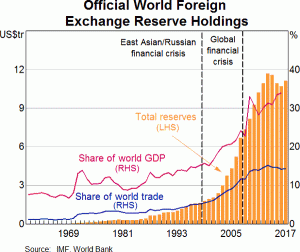
An important consequence of the sustained growth in reserve assets has been to shift the focus of reserve management increasingly toward return generation. As the opportunity costs from holding large, idle reserve portfolios begin to mount, the traditional mantra of ‘safety and liquidity’ ceases to adequately describe the reserve manager objective function. The increasing focus on generating returns has resulted in a partial convergence of reserve management investment practices with those of private institutional investors. This has found expression in various forms, including: growing allocations to higher yielding and more complex asset classes with procyclical return streams; more prevalent use of derivatives in tactical overlay strategies; growing use of securities lending programs to enhance returns; increased reliance on specialist external asset managers to gain access to asset classes where in-house expertise is lacking; and rising interest in relatively unconstrained total return (benchmark agnostic) strategies as a response to the low returns available on traditional reserve assets.
Reserve Management in the Crisis
Having traced out some key changes in reserve management practices, let me now turn to a discussion of reserve manager behaviour in the global financial crisis.
The first point to make is that despite the relative stability in the aggregate level of global reserves, reserve managers significantly cut exposure to foreign commercial banks in advanced economies at the same time many of these banks were forced to seek emergency liquidity assistance from host central banks in key financial centres. This is not to suggest that the behaviour of reserve managers was irrational, only to point out that major central banks were effectively ‘re-liquifying’ the reserve management departments of their foreign counterparts. Between Q2-2007 and Q4-2010, reserve manager deposits with foreign commercial banks more than halved, a decline of more than US$300 billion (Graph 2). The retrenchment was broad-based, with around half of surveyed central banks pulling deposits, and a majority shortening deposit terms.[3] Continental European banks, to which reserve managers had been attracted by the high rates on US dollar deposits, were particularly hard hit by reserve manager deposit outflows (Graph 3).[4] Recall the resulting destabilization of the dollar funding base of non-US banks necessitated emergency swap line intervention by the Federal Reserve totalling more than half a trillion dollars. Reverse repo exposures with US commercial banks were initially more resilient than bank deposits, until they too were cut sharply by foreign official investors in the post-Lehman panic.
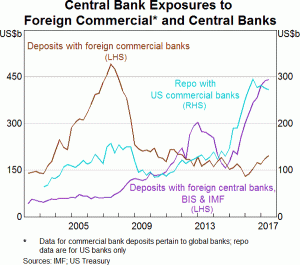
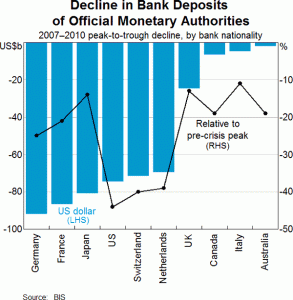
A second demonstration of procyclical reserve management was evident in the heavy net sales of US government agency debt and other short-dated credit product in favour of US Treasury bills (Graph 4). Having intensified their search for yield when spreads were narrow, reserve managers then liquidated as spreads widened. Ironically, agency securities had been accumulated at least in part on the presumption of US federal government support, but when that support materialized, official sector demand was absent.[5] Official holdings of agency debentures and bills, which had risen strongly prior to the crisis, were cut by US$360 billion, or more than half, over the two years to June 2010, while Treasury bill holdings, which had drifted lower in the years prior, surged from less than $US200 billion in December 2006 to a peak of more than $US600 billion in August 2009. This drove up the share of total outstanding Treasury bills held by foreign official investors from 19 to 29 percent.[6]
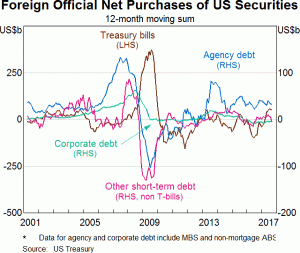
Third, heavy reliance on credit ratings contributed to forced sales of downgraded securities, and resulted in the suspension or overhaul of rebalancing programs that otherwise would have provided countercyclical support for assets most under strain. The percentage of reserve managers for whom bank debt, mortgage and asset backed securities were deemed investable asset classes fell by around half relative to 2007 levels (Graph 5), and around one-third of surveyed central banks cut exposure to government bonds that were downgraded.[7] On their own admission, rating downgrades, more than any other factor, prompted key changes to the asset allocation of reserve managers (Graph 6).
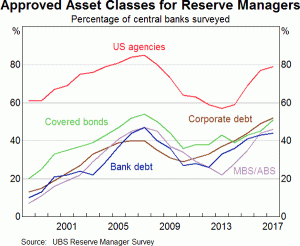
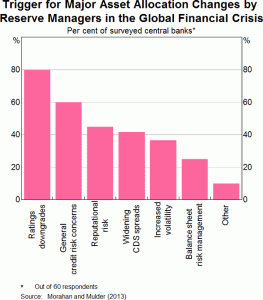
A fourth manifestation of procyclical behaviour was seen in the halt to externally managed securities lending programs, which, while possibly individually rational, inadvertently contributed to the run on shadow banking. In the years prior to 2008, securities lending programs became a popular way for reserve managers to increase the return on high quality, low yielding securities in scarce supply.[8] But not all conducted the same level of oversight of reinvested cash collateral as with the direct management of their regular cash holdings. Some reserve managers with limited experience in securities lending were surprised to find indemnity provisions covered only the failure of a counterparty to return lent securities, not losses incurred on reinvested cash. Additionally, because eligibility restrictions were often stipulated in terms of generic credit ratings, and structured product yields exceeded those on plain vanilla securities, cash raised through securities lending often found its way into shadow banking vehicles unbeknown to the reserve manager. As the crisis intensified, reports that custodians were gating the vehicles in which reserve manager cash collateral had been placed sparked a wholesale retreat. Reserve manager securities lending programs fell from $340 billion in August 2008 to $150 billion in the first half of 2009, with between one-quarter and one-half of lending programs reportedly shutdown entirely or materially de-risked.[9]
Finally, just over half of surveyed reserve managers conceded their response during the crisis highlighted a policy conflict between the core stabilization function of central banking in general, and their own investment actions during the panic.[10] This reflected not only the direct impact of their actions on pricing and liquidity conditions in the international financial system, but also problematic signalling effects.
Looking Ahead
A decade on from the crisis, it seems timely to take stock and ask whether changes in the size and composition of reserve assets, and how they are managed, might have any implications for international financial stability in the years ahead.
Some Grounds for Encouragement
I will begin with the encouraging news. First, uncollateralized deposit exposures with foreign commercial banks have reduced substantially as a share of reserve manager portfolios, from 15 percent in 2006 to just 3 percent more recently (Graph 7). This suggests reduced scope for reserve manager withdrawals to disturb the funding base of internationally active commercial banks.
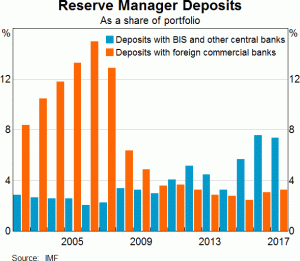
Second, events during the crisis have prompted reserve managers to deepen their analysis of the unstable relationship between credit and liquidity risk. There is now wider recognition that assets with generally low risk of default, such as quasi-government securities, may still turn illiquid in a crisis. To the extent this has translated into more carefully calibrated liquidity buffers, we might expect future periods of market turbulence to elicit a less disruptive response from reserve managers.
Third, reserve managers, like many other asset owners, are now more attuned to the risks associated with securities lending programs, and counterparty risk more broadly. With greater awareness of how things can go wrong, this should reduce the risk of another round of synchronized redemptions from vehicles (including those synonymous with shadow banking) in which cash collateral is sometimes invested.[11]
Fourth, new accounting provisions could potentially make a useful contribution in dampening procyclical portfolio adjustments by reserve managers. For instance, as a result of the transition from IAS39 to IFRS9, which will formally apply to around fifty central banks (with around half that number again also expected to use it for guidance), credit loss provisioning will be based more on relatively stable through-the-cycle estimates than backward-looking realized losses. Additionally, the abolition of the so-called ‘tainting rule,’ which required an entire hold-to-maturity portfolio to be marked-to-market in the event just a single security from this tranche was sold before maturity, could also assist reserve managers in carrying more volatile exposures through the cycle.
And fifth, temporary bilateral FX swap lines have now been converted into a larger, more permanent network of standing arrangements between six central banks in major financial centres,[12] and an array of open ended swap arrangements among other central banks has also been established. With a more coordinated safety net in place, there are grounds to think that unexpected FX liquidity demands could, at the margin, be better accommodated.
Some Remaining Sources of Uncertainty
Nevertheless, this is not to suggest that developments since the crisis universally point to a benign future impact of reserve managers on financial system functioning. For a start, the asset pool overseen by reserve managers is both more concentrated and considerably larger than before the crisis. The share of worldwide reserves managed by a small number of countries has edged higher, with three countries managing nearly half, and ten nearly three-quarters (Graph 8). Additionally, reserves have risen by 55 percent, or $4 trillion, since Q1-2009. Put in broader context, this a flow that exceeds the entire stock of assets managed by the global hedge fund industry.
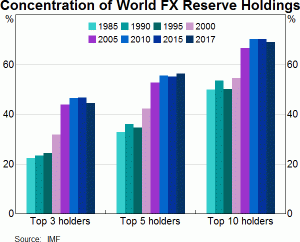
Partly as a result, the foreign official ownership share of various asset classes has either remained high or has risen further. For instance, it remains elevated in the case of US sovereign debt (Graph 9), has risen noticeably in the case of debt issued by non-traditional reserve issuing countries (Graph 10), and is also rising in relatively risky asset classes (Graph 11). The allocation in FX reserves to currencies that tend to be sensitive to changes in global growth expectations has also risen.[13]
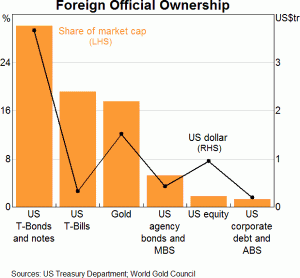
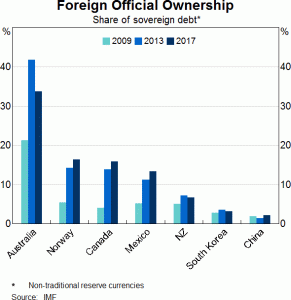
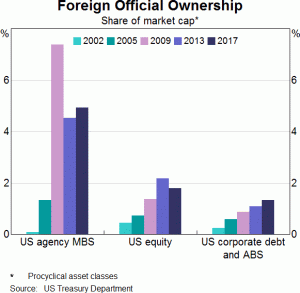
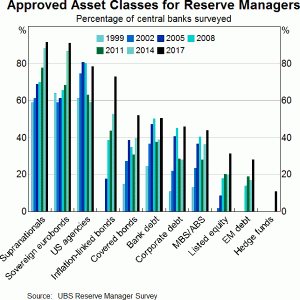
It should also be acknowledged that measures aimed at reducing the mechanistic reliance on credit ratings appear to have had limited traction with reserve managers, leaving open the possibility of future firesales induced by rating downgrades. Around half of surveyed reserve managers continue to automatically divest exposure when minimum credit thresholds are breached (typically a AA or A rating),[15] a figure that has barely declined following the issuance of the FSB’s Principles (later endorsed by the G20) which was aimed at severing the link between downgrades and forced selling.
It is similarly uncertain as to whether the proliferation of FX swap line arrangements since the crisis will prove as effective as we hope. History counsels that the effectiveness of swap lines as safety nets can only really be gauged in a crisis-type environment, due in part to uncertainties over conditionality provisions and political economy constraints. The Chiang Mai initiative, which since inception in 2000 has no record of activation, offers some food for thought. And it should be noted that some of the swap line arrangements established in recent years were designed to facilitate trade flows, not deal with liquidity crises.
Finally, flow patterns in the three mini-shocks since the global financial crisis–over euro area breakup concerns in 2011, the ‘taper tantrum’ of 2013, and the RMB ‘devaluation’ of 2015–suggest that reserve manager procyclicality has been tamed but not eliminated (Graph 13). In the 2011 and 2015 episodes, reserve managers again sold risk assets, withdrew deposits from commercial banks and increased deposits with the BIS–just as in the global financial crisis (albeit on a reduced scale). In the taper tantrum, reserve managers also moved in the direction of the wider market. But in general, the flows in these episodes were smaller than in the crisis, making it difficult to draw firm conclusions. An optimistic interpretation would be that the reduced magnitude of procyclical flows indicates better preparedness by reserve managers. A less benign inference is that these actions simply accord with the reduced severity of the post-2008 economic disturbances, leaving open the possibility that a larger shock could still elicit a wave of destabilizing flows from reserve managers.
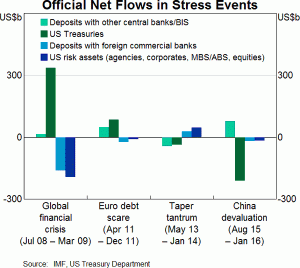
Dampening Procyclicality–What Can Be Done?
The discussion to this point begs the question as to what can be done, if anything, to help ensure the aggregate behaviour of reserve managers is a little less procyclical in future stress periods. While acknowledging the inherent difficulties, I believe it is too pessimistic, or fatalistic, to suggest nothing can be done. But it will require taking measures that are analogous to fixing the roof while the sun is shining, for if not adequately prepared in advance, reserve managers will likely again be left with suboptimal choices in a crisis.
Governance
Managing investment risk on a through-the-cycle basis requires a governance structure that can accommodate inevitable periods of discomfort occasioned by volatility. This is especially pertinent where the growth in reserves has increased the sensitivity of the profits and capital position of the central bank to fluctuations in the value of the reserve portfolio.[16] For legitimate reputational reasons, central banks can also be highly sensitive to credit risk incurred in reserve portfolios, well beyond the financial loss that may result. The asymmetry by which reserve managers are praised quietly when generating profits, but criticized loudly when incurring losses, can entrench incentives to run with the herd in times of stress.[17]
Two elements might be helpful in addressing these sensitivities. First, an increased focus on return generation should be accompanied by formal engagement of the executive. Where strategic decisions about the reserve portfolio are framed in the broader context of what is an acceptable risk-return trade-off for the institution as a whole, reserve managers should have greater confidence that their actions have institutional-wide support–including where these actions might generate valuation losses on occasion.[18] Similarly, and notwithstanding the highly-country specific nature of external governance arrangements, a policy of preemptive external stakeholder engagement on the rationale for accepting certain types of risks–and thus the volatility and losses the institution can expect to experience over a cycle–can mitigate costly knee-jerk reactions (and in extremis, threats to political independence) during difficult times. Disclosure practices must aim at striking the difficult balance between, on the one hand, harvesting the legitimacy-enhancing gains from providing transparency to key stakeholders, while at the same time, managing the pressure to divest (rationally held) exposures when losses are accumulating.[19]
A final point on institutional design is worth making here. Some have argued for the purging of credit and liquidity risk from reserve portfolios altogether, in favour of having these exposures managed exclusively in savings-based SWFs–those with the single objective of return generation. While this approach might be advantageous in some settings, it is also possible that if SWFs do not operate with the appropriate governance structure and institutional incentives, procyclicality among sovereign investors may simply continue under the guise of a different owner.[20]
Tranching
The crisis was a visceral reminder of the costliness of underestimating liquidity needs. It is notable that more central banks reported problems with the liquidity of their reserves than the level per-se.[21] The tranching of reserves into distinct liability-immunizing and riskier investment portfolios requires careful calibration–too few resources in the former will result in the less liquid, procyclical risk exposures in the latter having to be sold at the worst time to make up the shortfall. And it is easier said than done, reflecting the inherent uncertainties in estimating tail risk and regime-shifting variables like market liquidity, which standard risk management techniques struggle to accommodate. But just as refining estimates of reserve adequacy has attracted renewed attention since the crisis,[22] so too there is need for reserve managers to strengthen their analysis of time-varying microstructure conditions in the asset classes in which they invest.[23]
Procyclical Risk Management
The crisis revealed considerable mechanical reliance on inputs that tightly covary with the economic cycle–credit ratings, CDS spreads and price volatility–in driving the risk management and portfolio rebalancing actions of reserve managers. While these data can serve as useful inputs for the market surveillance activities of central banks, their application in a reserve management context requires careful consideration. Mechanistic reliance on credit ratings can lead to forced selling in stressed market conditions and unintentionally increase concentration risk in the remainder of the portfolio. Alternative approaches have included the following: using threshold breaches to trigger risk reviews rather than involuntary selling;[24] combining procyclical indicators like credit ratings and CDS spreads with various other (slower moving) inputs in the risk management and benchmarking process; and spreading asset sales across a rating corridor rather than concentrating sales at a single binary threshold. More generally, risk management should ideally have a forward-looking orientation. This is where stress testing and scenario analysis can be helpful in reducing the scope for unpleasant surprises and ameliorating purely reactive portfolio adjustments.
Duration Targets
When duration targets are frequently set on the basis of fixed return objectives–as surveys have reported[25]–this can perversely lead to maximum risk taking when spreads are tightest and bond yields lowest. Where possible, the term structure of liabilities should feature as the key determinant of duration exposure,[26] with return targets periodically reset in the context of prevailing risk-free yields to reduce the pressure on reserve managers to reach for yield–action that might expose the institution to risks it is ill-suited to bear.
 Leaning Against the Wind in Reserve Currencies
Leaning Against the Wind in Reserve Currencies
Finally, though the conservative orientation of many reserve managers constrains their ability to lean against trends in risk assets, the public policy case for leaning into persistent flow imbalances in reserve currencies may well be stronger. For instance, a wide cross currency basis emanating from imbalanced market conditions (i.e. one-way flows)[27]–such as that seen most notably in the Japanese yen in recent years owing to domestic institutional hedging of foreign assets–can see hedging costs become so prohibitive they prompt investors and corporations to run unhedged currency risk, even if they are not well equipped to deal with the possible consequences. By leaning into a widening basis, reserve managers stand to both harvest additional yield in reserve currencies, and play a constructive role in rebalancing the market, thus encouraging the prudent hedging of cross-border capital flows. [28]
Concluding Remarks
If leaning against the wind has long characterized the response function of central banks in general–think countercyclical monetary policy and emergency lending during banking panics–events during the global financial crisis suggest this has not always been the case when it comes to reserve managers. Encouragingly, there are grounds to believe reserve managers will be better prepared for future bouts of instability in international markets, though there are, of course, no guarantees. To the extent reserve managers have greater awareness of both their capacity to carry various risk exposures through a cycle, and the potential for their collective actions to impact financial system functioning, this by itself is a welcome development. And to the extent reserve managers are able to provide stabilizing countercyclical flows that are in both the domestic and international interest, better still. This is easier said than done, but it shouldn’t preclude us from trying. Thank you.
References
Bank of England (2014), ‘Procyclicality and Structural Trends in Investment Allocation by Insurance Companies and Pension Funds,’ Discussion Paper, London.
Borio C, G Galati and A Heath (2008), ‘FX Reserve Management: Trends and Challenges,’ BIS Papers No 40, Basel.
Carver N (2013), ‘RBS Reserve Management Trends, 2013,’ Central Banking Publications, London.
Carver N, and E Glass (2017), ‘HSBC Reserve Management Trends, 2017,’ Central Banking Publications, London.
Debelle G (2017), ‘How I Learned to Stop Worrying and Love the Basis’, Dinner Address at the BIS Symposium: CIP-RIP?, Basel.
Eichengreen B, and M Flandreau (2016), ‘A Century and a Half of Central Banks, International Reserves and International Currencies,’ in M D Bordo, O Eitrheim, M Flandreau and J F Qvigstad (eds), ‘Central Banks at a Crossroads: What Can We Learn from History?’ Cambridge University Press, Cambridge.
Eichengreen B, L Chitu, and A Mehl (2016), ‘Stability or Upheaval? The Currency Composition of International Reserves in the Long Run,’ IMF Economic Review, Vol 64, No 2, Washington DC.
IMF (2013), ‘Guidelines for Foreign Exchange Reserve Management,’ International Monetary Fund, Washington DC.
IMF (2016), ‘Guidance Note on the Assessment of Reserve Adequacy and Related Considerations,’ International Monetary Fund, Washington DC.
Jones, B (2016), ‘Institutionalizing Countercyclical Investment: A Framework for Long-term Asset Owners,’ IMF Working Paper 16/38, Washington DC.
Jones, B (2017), ‘Leaning With the Wind: Long-term Asset Owners and Procyclical Investment,’ Journal of Investment Management, 15(2): 1–23.
Jones, B (2018), ‘Central Bank Reserve Management and International Financial Stability: Some Post-Crisis Reflections,’ IMF Working Paper 18/31, Washington DC.
McCauley, R N (2008), ‘Choosing the Currency Numeraire in Managing Official Foreign Exchange Reserves,’ in R Pringle and N Carver (eds), ‘RBS Reserve Management Trends 2008,’ Central Banking Publications, London.
McCauley, R N and J F Rigaudy (2011), ‘Managing Foreign Exchange Reserves in the Crisis and After,’ BIS Papers No 58, in ‘Portfolio and Risk Management for Central Banks and Sovereign Wealth Funds,’ Proceedings of a Joint Conference Organised by the BIS, ECB and World Bank, Bank for International Settlements, Basel.
Morahan, A and C Mulder, (2013), ‘Survey of Reserve Managers: Lessons from the Crisis,’ IMF Working Paper 13/99, Washington DC.
OECD (2014), ‘Institutional Investors and Long-term Investment,’ Project Report, Paris.
Pihlman, J and H van der Hoorn (2010), ‘Procyclicality in Central Bank Reserve Management: Evidence from the Crisis,’ IMF Working Paper 10/150, Washington D.C.
Pringle, R and N Carver (2009), ‘RBS Reserve Management Trends, 2009,’ Central Banking Publications, London.
Truman E M, and A Wong (2006), ‘The Case for an International Reserve Diversification Standard,’ Working Paper 06–2, Institute for International Economics, Washington DC.
Endnotes
This material draws heavily on research undertaken by the speaker at the IMF (see Jones (2018), ‘Central Bank Reserve Management and International Financial Stability: Some Post-Crisis Reflections,’ IMF Working Paper 18/31, Washington DC; interested readers can find a more extensive list of references therein). As such, the views expressed here should not necessarily be construed as reflecting those of the Reserve Bank of Australia.[*]
See for instance, Pihlman and van der Hoorn (2010), McCauley and Rigaudy (2011), Bank of England (2014), OECD (2014) and Jones (2016, 2017, 2018). Note that most of the related stability analysis on institutional investors has been concentrated on asset managers, rather than asset owners. However, sometimes lost in the discussion is that most asset managers are highly constrained vis-à-vis asset owners, and they are often viewed as responsible for actions that are essentially just the passing through of asset owner decisions. Asset owners are principally responsible for the large strategic shifts of capital across asset classes and geographies. And to the extent asset managers amplify procyclicality in their tactical decisions, it can be a rational response to performance appraisal terms imposed by asset owners.[1]
The merits of large scale reserve accumulation, most notably in East Asia, and the ‘uphill’ capital flows occasioned by it, have been the subject of intense policy debate. It is beyond the scope of this speech to weigh in on this discussion, other than to point out that one of the few areas of general agreement has been the emphasis on international reserves in serving as collateral for economies pursuing an export-led growth strategy with external borrowing constraints.[2]
Morahan and Mulder (2013), Pringle and Carver (2009).[3]
Foreign central banks and US MMFs were the two main sources of dollar funding for non-US banks prior to the crisis.[4]
Official holdings of agency mortgage backed securities held up much better than agency bills and debentures. It is an open question as to whether purchases by the US Federal Reserve of agency debentures were at least partly motivated by knowledge that reserve managers were selling.[5]
When the US Treasury accommodated the Federal Reserve’s decision to sterilize dollars swapped with European central banks, it overfunded its cash flow needs by selling extra Treasury bills and depositing the proceeds in the Federal Reserve Bank of New York. As noted in McCauley and Rigaudy (2011), this meant there were more bills available into which foreign central banks and MMFs could flee.[6]
Morahan and Mulder (2013).[7]
The incentive for agents to engage in maturity, liquidity and credit transformation was magnified where securities lenders operated a profit-sharing arrangement with the central bank.[8]
McCauley and Rigaudy (2011), Morahan and Mulder (2013).[9]
Pringle and Carver (2009), Morahan and Mulder (2013).[10]
This has been reflected in numerous ways, including greater focus on the reinvestment risk of cash collateral, more prescriptive investment eligibility requirements, more intrusive supervision and transparency to ensure compliance with these guidelines, and more rigorous counterparty controls.[11]
This network comprises the Bank of Canada, the Bank of England, the Bank of Japan, the European Central Bank, the Federal Reserve, and the Swiss National Bank. These arrangements allow for the provision of liquidity in each jurisdiction in any of the five currencies foreign to that jurisdiction.[12]
See the IMF’s COFER database. Additionally, in a recent survey of 80 central banks accounting for half of world FX reserves, Carver and Glass (2017) report the following share of reserve managers which now have exposure to non-traditional reserve currencies: 55 percent in the Australian dollar, 47 percent in the Canadian dollar, 29 percent in Swedish krona, 27 percent in the Norwegian krone, 23 percent in the New Zealand dollar, 20 percent in the Danish krone, 15 percent in the Singapore dollar, and 12 percent in the South Korean won. For a review of changes in the currency composition of reserves since World War II, see Eichengreen et al. (2016).[13]
A caveat is in order here–the concept of risk in a total portfolio context can differ from that when viewing (relatively volatile) asset classes on a standalone basis. The introduction of non-traditional asset classes in the portfolio mix may be driven at least in part by a desire to hedge the risk factors associated with large, concentrated exposures in sovereign fixed income. For instance, reserve managers with exposure to listed equities often justify their inclusion on the basis of their purported inflation and interest rate hedging properties, without having to sacrifice liquidity. Diversification beyond core sovereign bond markets may become a more pressing issue as reserve currency issuing central banks begin unwinding unconventional monetary policy.[14]
Morahan and Mulder (2013); Carver (2013).[15]
In the case where reserves exceed insurance needs and the domestic currency is used for determining reported losses for accounting purposes, it is a natural candidate as numeraire for institutions that are highly sensitive to valuation losses. A number of central banks have publicly rationalized adjustments to their portfolio allocations with the desire to limit the variability of the value of the portfolio measured in domestic currency. See McCauley (2008), Borio et al. (2008) and IMF (2013) for related discussion on the choice of numeraire.[16]
These sensitivities can derive from asymmetric income distribution rules where central bank profits (owing, at least in part, from valuation changes in the reserve portfolio) are routinely paid out to the government, while losses are not replenished through automatic recapitalization.[17]
Particularly where in-house expertise is lacking, some institutions have investments in risky asset classes outsourced to third party managers in an effort to shield themselves from reputational risk which can surface when losses are reported. This might also be done to avoid perceptions that the central bank is utilizing inside information for its own pecuniary benefit. Delegating authority to external managers is not, however, without its own governance challenges, including principal-agent frictions and loss of oversight capacity.[18]
In the area of reserve management, there are no internationally binding disclosure practices–these are left to the discretion of national authorities, reflecting a mixture of economic, institutional and political factors. The IMF’s Special Data Dissemination Standard (SDDS) and Guidelines on Foreign Exchange Reserve Management(2013) come closest. See also, Truman and Wong (2006).[19]
Norway was the most prominent example of a SWF whose governance structure allowed it to maintain a steady, countercyclical orientation through the depths of the crisis.[20]
Morahan and Mulder (2013).[21]
See IMF (2016).[22]
While stepped up market surveillance activities can assist in this regard, they cannot substitute for more formal portfolio stress testing techniques.[23]
Half of the managers surveyed in Carver (2013) report having increased resources in recent years to develop internal credit assessment capabilities.[24]
Morahan and Mulder (2013).[25]
In this context, the concept of liabilities relates more to the precautionary purposes for holding reserves, i.e. the policy objectives they serve and the conditions under which they may be drawn. This is a somewhat different concept from the direct funding cost of reserves, captured by ‘tangible’ on-balance sheet liabilities typically comprised of currency in circulation and commercial bank reserves–both of which are difficult to pin down from a duration/interest rate sensitivity perspective (currency in circulation is a perpetuity with no interest rate, and reserves may or may not be remunerated at the policy rate). Admittedly, basing duration hedging benchmarks on ‘virtual’ (or contingent) liabilities as distinct from tangible liabilities could create communication challenges with respect to the accounting treatment of changes in asset and liability valuations.[26]
The cross currency basis represents the cost differential between borrowing in the currency swap market and the physical money or bond market. If covered interest parity (CIP) holds, the basis should be zero. Prior to the global financial crisis, only negligible deviations from CIP were documented, even during periods of high volatility, but significant deviations have since become commonplace as commercial dealers and other private sector agents have retreated from the foreign exchange market. This is consistent with the “limits to arbitrage” literature which has ballooned since the late 1990s. Unbalanced hedging flows largely explain why the basis has opened up in the first instance.[27]
For an Australian perspective, see Debelle (2017) and the RBA’s 2017 Annual Report. More broadly, Carver and Glass (2017) report that around one quarter of surveyed reserve managers have lent into the negative basis since 2016.



 Leaning Against the Wind in Reserve Currencies
Leaning Against the Wind in Reserve Currencies





